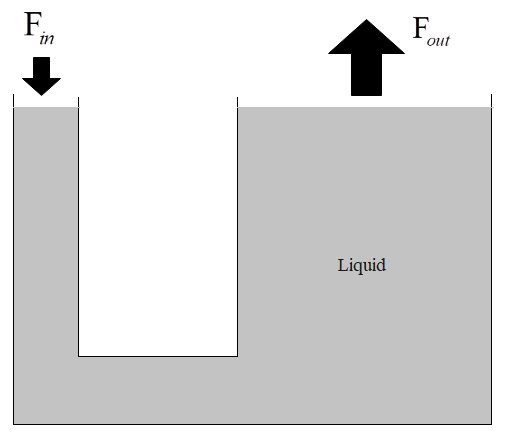
In a hydraulic lift, the small piston has an area of $2\text{ c}{{\text{m}}^{2}}$ and the large piston has an area of $80\text{ c}{{\text{m}}^{2}}$. What is the mechanical advantage of the hydraulic lift?
$\text{A}\text{. 40}$
$\text{B}\text{. 42}$
$\text{C}\text{. 10}$
$\text{D}\text{. 04}$


Answer
571.2k+ views
Hint: Mechanical advantage is the ratio of force produced by any machine to the force applied on it. Use Pascal’s principle to calculate mechanical advantage of the hydraulic lift.
According to Pascal’s law, “when a static pressure is applied on an incompressible liquid, it is distributed or transmitted equally throughout the liquid in all directions.”
Complete step-by-step answer:
A hydraulic lift is a system consisting of two pistons of different sizes which are connected by a reservoir filled with hydraulic liquid. When a smaller input force is applied on a smaller piston, it results in greater force on a large piston. So there is a mechanical advantage. This property makes it possible to lift heavy motor-cars by applying lesser force.
To calculate the mechanical advantage of the hydraulic lift we use Pascal’s principle. According to Pascal, liquids cannot be compressed and they distribute the pressure equally.
Therefore pressure at smaller piston equals the pressure at large piston and we know that pressure is calculated as force per unit area. Therefore
$\dfrac{{{F}_{in}}}{{{A}_{s}}}=\dfrac{{{F}_{out}}}{{{A}_{L}}}$
Where
${{F}_{in}}=$Force applied on smaller piston
${{F}_{out}}=$Resulting force on large piston
${{A}_{1}}=$Area of small piston
${{A}_{2}}=$Area of large piston
We note from the question that ${{A}_{1}}=2\text{ c}{{\text{m}}^{\text{2}}}$and ${{A}_{2}}=80\text{ c}{{\text{m}}^{2}}$. On substituting these values in Pascal’s relation we get
$\dfrac{{{F}_{in}}}{2}=\dfrac{{{F}_{out}}}{80}$
Now we rearrange the expression and obtain mechanical advantage
$\begin{align}
& \dfrac{{{F}_{in}}}{{{F}_{out}}}=\dfrac{80}{2} \\
& \Rightarrow \text{ Mechanical advantage = 40} \\
\end{align}$
So, the correct answer is “Option A”.
Additional Information: Mechanical advantage is unitless quantity as it is the ratio of input and output forces.
Several other devices like hydraulic brakes, hydraulic pressure jacks are based on the same principle.
Note: Any force applied to a liquid is transmitted uniformly in all directions throughout the liquid. One of its consequences is Pascal’s ball. Pascal’s ball is a rubber ball with multiple holes in it. When water is filled and pressure is applied water flows out from all its holes with the same speed.
According to Pascal’s law, “when a static pressure is applied on an incompressible liquid, it is distributed or transmitted equally throughout the liquid in all directions.”
Complete step-by-step answer:
A hydraulic lift is a system consisting of two pistons of different sizes which are connected by a reservoir filled with hydraulic liquid. When a smaller input force is applied on a smaller piston, it results in greater force on a large piston. So there is a mechanical advantage. This property makes it possible to lift heavy motor-cars by applying lesser force.
To calculate the mechanical advantage of the hydraulic lift we use Pascal’s principle. According to Pascal, liquids cannot be compressed and they distribute the pressure equally.
Therefore pressure at smaller piston equals the pressure at large piston and we know that pressure is calculated as force per unit area. Therefore
$\dfrac{{{F}_{in}}}{{{A}_{s}}}=\dfrac{{{F}_{out}}}{{{A}_{L}}}$
Where
${{F}_{in}}=$Force applied on smaller piston
${{F}_{out}}=$Resulting force on large piston
${{A}_{1}}=$Area of small piston
${{A}_{2}}=$Area of large piston
We note from the question that ${{A}_{1}}=2\text{ c}{{\text{m}}^{\text{2}}}$and ${{A}_{2}}=80\text{ c}{{\text{m}}^{2}}$. On substituting these values in Pascal’s relation we get
$\dfrac{{{F}_{in}}}{2}=\dfrac{{{F}_{out}}}{80}$
Now we rearrange the expression and obtain mechanical advantage
$\begin{align}
& \dfrac{{{F}_{in}}}{{{F}_{out}}}=\dfrac{80}{2} \\
& \Rightarrow \text{ Mechanical advantage = 40} \\
\end{align}$
So, the correct answer is “Option A”.
Additional Information: Mechanical advantage is unitless quantity as it is the ratio of input and output forces.
Several other devices like hydraulic brakes, hydraulic pressure jacks are based on the same principle.
Note: Any force applied to a liquid is transmitted uniformly in all directions throughout the liquid. One of its consequences is Pascal’s ball. Pascal’s ball is a rubber ball with multiple holes in it. When water is filled and pressure is applied water flows out from all its holes with the same speed.
Recently Updated Pages
Master Class 12 Business Studies: Engaging Questions & Answers for Success

Master Class 12 Economics: Engaging Questions & Answers for Success

Master Class 12 English: Engaging Questions & Answers for Success

Master Class 12 Maths: Engaging Questions & Answers for Success

Master Class 12 Social Science: Engaging Questions & Answers for Success

Master Class 12 Chemistry: Engaging Questions & Answers for Success

Trending doubts
What is meant by exothermic and endothermic reactions class 11 chemistry CBSE

Which animal has three hearts class 11 biology CBSE

10 examples of friction in our daily life

One Metric ton is equal to kg A 10000 B 1000 C 100 class 11 physics CBSE

1 Quintal is equal to a 110 kg b 10 kg c 100kg d 1000 class 11 physics CBSE

Difference Between Prokaryotic Cells and Eukaryotic Cells




